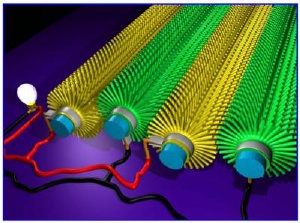Mar 26 2009
Imagine if all you had to do to charge your iPod or your BlackBerry was to wave your hand, or stretch your arm, or take a walk? You could say goodbye to batteries and never have to plug those devices into a power source again.
 Pictured is a schematic illustration shows the microfiber-nanowire hybrid nanogenerator, which is the basis of using fabrics for generating electricity. Credit: Professor. Z. L. Wang and Dr. X. D. Wang, Georgia Institute of Technology.
Pictured is a schematic illustration shows the microfiber-nanowire hybrid nanogenerator, which is the basis of using fabrics for generating electricity. Credit: Professor. Z. L. Wang and Dr. X. D. Wang, Georgia Institute of Technology.
In research presented here today at the American Chemical Society's 237th National Meeting, scientists from Georgia describe technology that converts mechanical energy from body movements or even the flow of blood in the body into electric energy that can be used to power a broad range of electronic devices without using batteries.
"This research will have a major impact on defense technology, environmental monitoring, biomedical sciences and even personal electronics," says lead researcher Zhong Lin Wang, Regents' Professor, School of Material Science and Engineering at the Georgia Institute of Technology. The new "nanogenerator" could have countless applications, among them a way to run electronic devices used by the military when troops are far in the field.
The researchers describe harvesting energy from the environment by converting low-frequency vibrations, like simple body movements, the beating of the heart or movement of the wind, into electricity, using zinc oxide (ZnO) nanowires that conduct the electricity. The ZnO nanowires are piezoelectric — they generate an electric current when subjected to mechanical stress. The diameter and length of the wire are 1/5,000th and 1/25th the diameter of a human hair.
In generating energy from movement, Wang says his team concluded that it was most effective to develop a method that worked at low frequencies and was based on flexible materials. The ZnO nanowires met these requirements. At the same time, he says a real advantage of this technology is that the nanowires can be grown easily on a wide variety of surfaces, and the nanogenerators will operate in the air or in liquids once properly packaged. Among the surfaces on which the nanowires can be grown are metals, ceramics, polymers, clothing and even tents.
"Quite simply, this technology can be used to generate energy under any circumstances as long as there is movement," according to Wang.
To date, he says that there have been limited methods created to produce nanopower despite the growing need by the military and defense agencies for nanoscale sensing devices used to detect bioterror agents. The nanogenerator would be particularly critical to troops in the field, where they are far from energy sources and need to use sensors or communication devices. In addition, having a sensor which doesn't need batteries could be extremely useful to the military and police sampling air for potential bioterrorism attacks in the United States, Wang says.
While biosensors have been miniaturized and can be implanted under the skin, he points out that these devices still require batteries, and the new nanogenerator would offer much more flexibility.
A major advantage of this new technology is that many nanogenerators can produce electricity continuously and simultaneously. On the other hand, the greatest challenge in developing these nanogenerators is to improve the output voltage and power, he says.
Last year Wang's group presented a study on nanogenerators driven by ultrasound. Today's research represents a much broader application of nanogenerators as driven by low-frequency body movement.